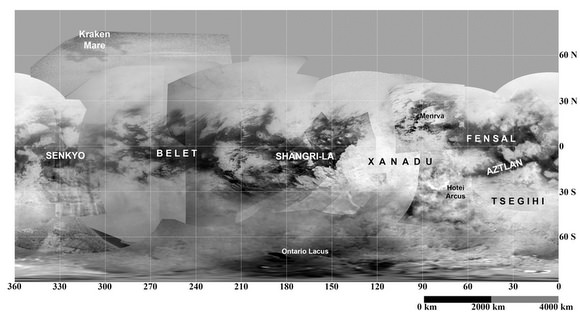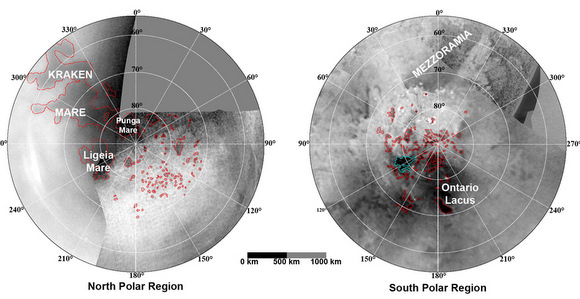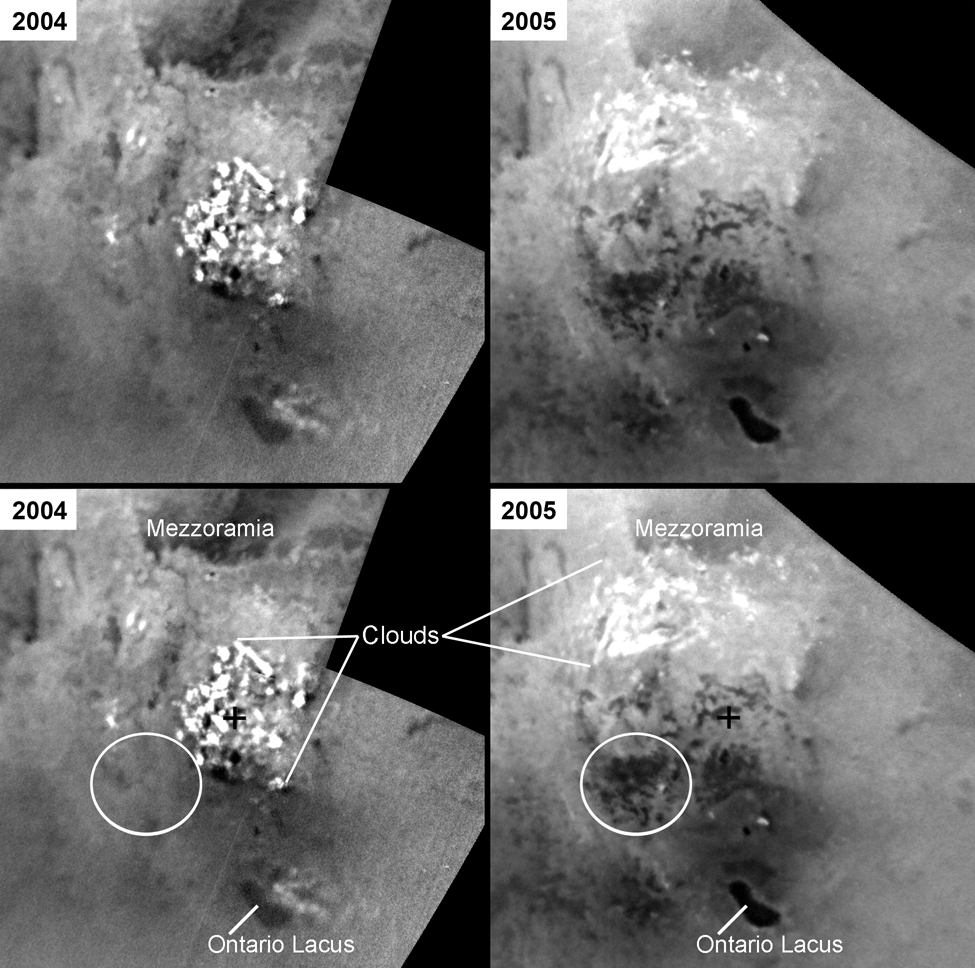[/caption]
Recent pictures from the Cassini spacecraft of Titan’s south polar region reveal new lake features not seen in images of the same region taken a year earlier. Extensive cloud systems seen in images covering the area during past year suggest that the new lakes could be the result of a large rainstorm and that lakes on Titan owe their presence, size and distribution to the moon’s weather and changing seasons. But there must also be large underground reservoirs as well of the liquids on Titan. Those liquids aren’t water, of course, but super-cold hydrocarbons like methane.
For several years, Cassini scientists have suspected that dark areas near the north and south poles of Saturn’s largest satellite might be liquid-filled lakes. Cassini’s Imaging Science Subsystem (ISS) have now surveyed nearly all of Titan’s surface, helping to create an updated global map.

Observations have documented greater stores of liquid methane in the northern hemisphere than in the southern hemisphere. And, as the northern hemisphere moves toward summer, Cassini scientists predict large convective cloud systems will form there and precipitation greater than that inferred in the south could further fill the northern lakes with hydrocarbons.
Some of the north polar lakes are large. If full, Kraken Mare — at 400,000 square kilometers — would be almost five times the size of North America’s Lake Superior. All the north polar dark ‘lake’ areas observed by ISS total more than 510,000 square kilometers — almost 40 percent larger than Earth’s largest “lake,” the Caspian Sea.
However, evaporation from these large surface reservoirs is not great enough to replenish the methane lost from the atmosphere by rainfall and by the formation and eventual deposition on the surface of methane-derived haze particles.
“A recent study suggested that there’s not enough liquid methane on Titan’s surface to resupply the atmosphere over long geologic timescales,” said Dr. Elizabeth Turtle, Cassini imaging team associate at the Johns Hopkins University Applied Physics Lab in Laurel, Md., and lead author of a paper published today in the journal Geophysical Research Letters. “Our new map provides more coverage of Titan’s poles, but even if all of the features we see there were filled with liquid methane, there’s still not enough to sustain the atmosphere for more than 10 million years.”
Combined with previous analyses, the new observations suggest that underground methane reservoirs must exist.

Titan is the only satellite in the solar system with a thick atmosphere in which a complex organic chemistry occurs. “It’s unique,” Turtle said. “How long Titan’s atmosphere has existed or can continue to exist is still an open question.”
That question and others related to the moon’s meteorology and its seasonal cycles may be better explained by the distribution of liquids on the surface. Scientists also are investigating why liquids collect at the poles rather than low latitudes, where dunes are common instead.
“Titan’s tropics may be fairly dry because they only experience brief episodes of rainfall in the spring and fall as peak sunlight shifts between the hemispheres,” said Dr. Tony DelGenio of NASA’s Goddard Institute for Space Studies in New York, a co-author and a member of the Cassini imaging team. “It will be interesting to find out whether or not clouds and temporary lakes form near the equator in the next few years.”
Titan and the transformations on its surface brought about by the changing seasons will continue to be a major target of investigation throughout Cassini’s Equinox mission.
Source: CICLOPS


I wonder how the fossil fuel cult will try and convince us that the hydrocarbons are biogenic?
Hopefully Cassini will spot a Cryovolcano. I would be very interested in an analysis of a sample of the ice. It would certainly give us an indication to how common life is
Simon,
Unfortunately for the 18th century biogenic hypothesis, no biological organism (psychrophile or cryophile) can survive at minus 179 degrees celsius, Colwellia psychrerythraea included.
The temperature in a cryovolcano would be much higher than the surface.
What evidence do you have of that?
Evidence? Knowing what a cryovolcano is.
A cyovolcano works as a regular volcano, bringing to the surface molten stuff that, at superficial temperatures, would be solid. The difference is in the nature of that stuff. Regular volcanos erupt molten rock; cyovolcanos erupt molten ices. In either case, the temperature of the erupted material is much higher than that of surrounding areas. That’s why it’s molten.
What temperature is the molten ice on Titan?
Let’s think about it for a moment.
What’s Molten Ice – it’s water.
Or a slurry of Ice and water.
The atmospheric pressure on Titan 141 kPa
(For reference the atmospherpheric pressure at MSL on earth is 101 kPa).
According to any phase diagram for water, the freezing point of pure water at 140 kPa is approximately 0°C.
This then means that the temperature of ‘molten ice’ on Titan is approximately 0°C. This remains true at pressures up to approximately 50 MPa, at which point the melting point of the ice begins to increase substantially.
Even if we assume the molten Ice on Titan is a fully saturated brine, that then only permits molten ice based cryovolcanism at temperature around -20°C water temperature.
So then, irrespective of what happens once said water reaches the surface, any psycrophilic bacteria capable of surviving in antarctic conditions is also capable of surving in the “magma chamber” of a Titan cryovolcanoe.
touche’
Trippy,
Water mixed with ammonia has a melting point significantly lower than 0°C.
And fully saturated brines, such as don juan pond in antartica, can remain liquid down to minus 55 deg c. But liquid water by any name interacting with the massive amounts of organics on titans surface has got to give us few clues as to how life gets going and how often it occurs.
could the methane be replenished from life on Titan?
Trippy,
Unfortunately for you the scientific method is based upon observation and not assumption.
Nexus: I’m aware of that – hence the reason why I was excplicitly clear about the types of water solutions I was considering.
Also, according to Mitri, Showman, Lunine and Lopes in “Cryovolcanism and Methane Outgassing on Titan” published in Lunar and Planetary Science XXXIX (2008); the ‘plausable range’ for cryomagma temperatures is -96°C – -34°C
So I was a little on the high side, but…
Marsburg: Really? Cool. Most of the info I found seemed to suggest the -20 ro -30 range.
OIM: Unfortumately for you, the scientific method involves actually opening your eyes and reading publications (see the reference I provided above).
Science requires observation. Liquid water had never been observed on Titan.
What do you suppose we’re doing at the labs in Antarctica?
OIM:
This is just funny. Are you denying Cryovolcanism?
Are you suggesting that the cryovolcanic features observed on Titans surface by Cassini-Huygens aren’t actually cryovolcanic?
What do you suppose is being errupted, if not water based slurries?
Can /you/ back up /your/ assertions?
The cryovolcanoes on Titan erupt methane and hydrocarbons up to octane. They do not erupt liquid water.
New Lakes on Titan: Hmm wonder what the fishing is like 🙂 It was this big <——–<
OIM:
Published scientific literature disagrees with you.
I thought you were interested in doing science?
Perhaps you have some proof as to why liquid water shouldn’t be present below the surface of Titan?
Trippy, science requires observation. No liquid water has ever been observed on Titan.
OIM:
Science requires evidence.
Science also requires supposition and interpretation of evidence.
That liquid exists on the surface of Titan is technically a supposition, based on the interpretation of evidence (although that evidence is compelling to the point of being overwhelming).
That the liquid that exists on the surface of Titan is Hydrocarbon is also supposition based on the interpretation of evidence.
Like wise that a layer of liquid water, or pockets of liquid water exist below the surface of Titan is supposition based on the interpretation of evidence (from observations).
Here are six papers that discuss the internal structureof Titan, including evidence for a liquid ocean(and its implications).
On the internal structure and dynamics of Titan O. Grasset, C. Sotin and F. Deschamps
Exobiological Implications of a Possible Ammonia–Water Ocean inside Titan A. D. Fortes
JPL: pia10243.htm
On Titans variable spin rate.
‘Electron conductivity and density profiles derived from the Mutual Impendence Probe measurements performed during the descent of Huygens through the atmosphere of Titan’, by M.Hamelin et al.,
‘A new numerical model for the simulation of ELF wave propagation and the computation of eigenmodes in the atmosphere of Titan: did Huygens observe any Schumann Resonance?’, by F. Simões et al.
JPL: cassinif-20070601-02.html
On Titan’s ELF emissions.
I’m done with this conversation – i’ve produced multiple papers which support my contentions, you have produced NOTHING.
You’ve been totally pwned in this conversation, however, i’d wager you won’t see it or admit it.
Feel free to have the last say though (because I know you wont be able to help yourself).